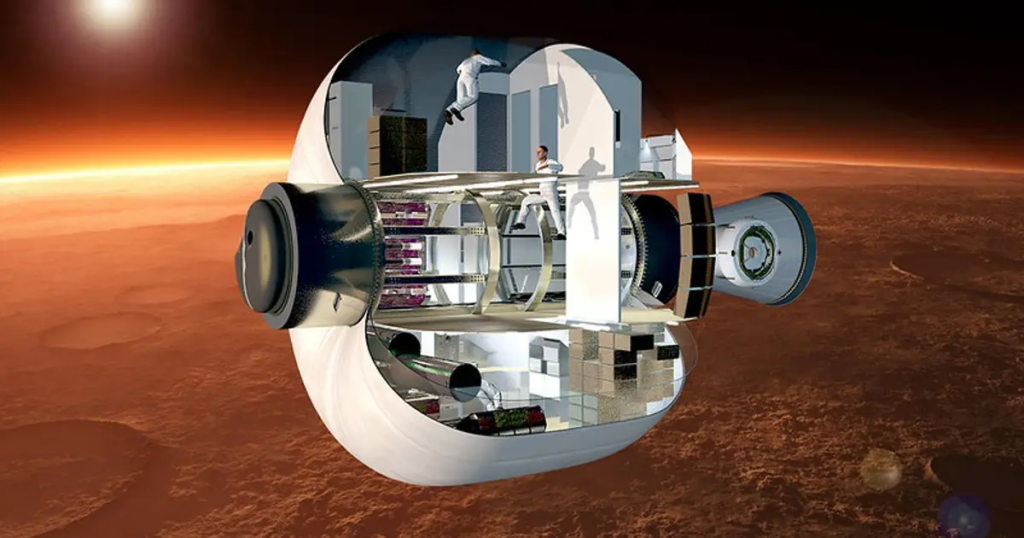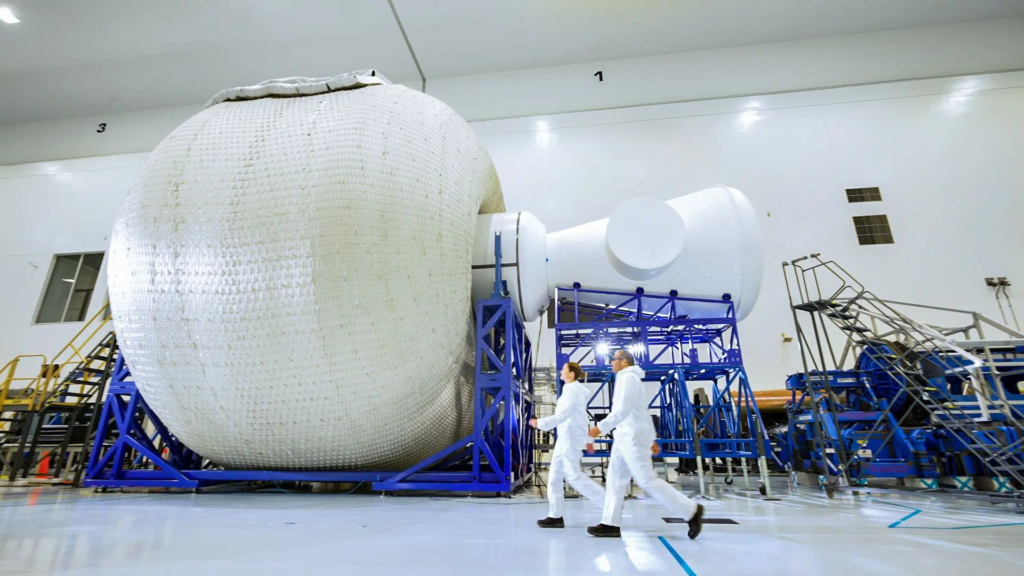
Sierra Space Continues To Make Progress On LIFE Habitat
While improving at a rapid pace, large payloads are still limited in size by the fairing of different available launch vehicles. When it comes to building a space station or habitats in space, this can make the process especially challenging. For years now Sierra Space has been developing and testing an inflatable habitat that expands once in orbit named LIFE.
Recently, the company formed a new partnership meant to facilitate a faster schedule and greater workforce for the job. With upcoming projects such as Orbital Reef relying on this technology, the development of LIFE is very important. Combine its unique design with its massive size when inflated and it could change how humans live in space.
In the past couple of months, we have seen consistent testing of different scale models. These include ultimate burst pressure tests where the company pressurizes the habitat until it explodes. Since the space environment is so harsh, these tests are necessary to prove it’s a safe system. Here I will go more in-depth into the new partnership, LIFE testing, what to expect in the coming months, and more.
New Partnership

Just over a week ago, Sierra Space tweeted saying, “Sierra Space and @ILCdoverastro have formed a long-term partnership to build the infrastructure in space to accelerate LIFE habitat installation and the next generation of spacesuits to accelerate the commercialization of low-Earth Orbit.” Specifically, the partnership is intended to accelerate the on-orbit installation of affordable and high-volume LIFE™ (Large Integrated Flexible Environment) inflatable modules that will be the catalyst for the commercialization of space leveraging the Sierra Space platform. The two companies have also partnered to design the next generation of spacesuits for both extra- and intra-vehicular activity (EVA and IVA).
After being launched, the habitat is inflated to a structure 8.2 m (27 feet) in diameter. It will feature three floors of living and working area to support crews of 4-12 (depending on desired application). The soft goods inner pressure shell layer is composed of Vectran fabric weave that is stronger than steel and tough enough to withstand the internal pressure required for the crew to live and work comfortably for extended periods of time. The soft goods Outer Layers arevcomposed of a series of materials that form the MMOD and MLI layers designed for orbital debris and thermal protection. On the three separate floors, the habitat will consist of everything a crew of astronauts would need to live in space and perform science missions. This includes science labs, robotics work stations, medical and sick bay, sleep and hygiene quarters, galley, exercise equipment, Sierra Space’s Astro Garden plant growth system, and ample storage room for crew supplies.
Sierra Space CEO Tom Vice commented, “We are building the first commercial end-to-end platform in space that will provide the necessary affordable unit economics, with our large expandable family of space modules, to accelerate biotech and industrial companies to design and build their next breakthrough products in our microgravity factories. This technology will scale quickly, allowing our team to put into LEO a single module with comparable volume to the entire ISS – also in a single launch.”
The reason this partnership is significant is that ILC Dover will be an exclusive partner with Sierra Space for softgoods used to support inflatable space habitat systems for low-Earth orbit (LEO), lunar and Mars transport and surface habitation, and use cases even farther into deep space. ILC Dover has years of experience, and has been apart of significant projects including creating spacesuits for NASA.
Since July 2022, Sierra Space and ILC Dover have joined NASA in successfully completing a variety of pressure tests on one-third-scale versions of LIFE. All four tests exceeded NASA’s certification requirements and demonstrated the inflatable structure’s integrity for sustaining human life in space for greater than 60 years. The companies and NASA will continue to collaborate on the next series of one-third scale LIFE certification tests, which will focus on inserting hard structures into the pressure shell and correlating the results to previous tests. Full-scale LIFE habitat tests should begin later this year. These will be the first full scale tests and one of the final steps before the system is ready to go to space and test what’s possible.
LIFE Habitat

While the LIFE Habitat is very unique, it’s not necessarily the first of its kind. For example, the Bigelow Expandable Activity Module (BEAM) is an experimental expandable space station module developed by Bigelow Aerospace, under contract to NASA, for testing as a temporary module on the International Space Station (ISS) from 2016 to at most 2028, when the contract can not be extended any further. It arrived at the ISS in 2016, was berthed to the station days later, and was expanded and pressurized not long after. Although originally planned to be a two year test, it has exceeded expectations and is used as additional cargo storage. The module is under the ownership of NASA after Bigelow Aerospace suspended operations in 2021.
As far as its results, NASA noted in 2017 that, after spending one year in space, the BEAM instrumentation had recorded “a few probable micrometeoroid debris impacts” but that the module’s protective layers had resisted penetration. Early results from monitors inside the module have shown that galactic cosmic radiation levels are comparable to those in the rest of the space station. Further testing will try to characterize whether the inflatable structure is any more resilient to radiation than traditional metal modules. While it’s performed much better than expected, it did have a few problems at the beginning.
The first attempt at module inflation took place in 2016, and was suspended after higher-than-expected air pressure inside BEAM was detected with minimal expansion of the module. The attempt was terminated after two hours. The failure to expand and unfold may be a result of the unanticipated 10-month delay in module inflation, which may have caused the fabric layers to stick together. The module was expanded over the course of seven hours, with air being injected 25 times for a total of 2 minutes 27 seconds. Its length was extended 170 cm (67 in) from its stowed configuration, 2.5 cm (0.98 in) less than expected. After expansion was complete, air tanks aboard BEAM were opened to equalize air pressure in the module with that of the ISS.
While impressive, the LIFE Habitat features a few significant differences. For one, BEAM features a diameter of 2.4 meters (8 feet) while LIFE is more than three times bigger with a 8.2 meter diameter. On LIFE, the inner layer, called the bladder, is made of urethane and is designed to keep the air inside the habitat without leaking. As partially mentioned prior, the LIFE habitat also has a woven structural layer (pressure shell), called the restraint layer, which is strong enough to withstand the internal pressure required for the crew to live and work. It is protected by an MMOD multi-layer soft-goods shield that guards the habitat against space debris such as micrometeoroids. The layers of fabric, plus the internal outfitting, create ample safeguards against radiation.
All of the air and water required to survive in space is delivered by logistics carriers to the habitat, where it is then stored until needed. The LIFE habitat has life support systems that regulate the air to maintain proper pressure, temperature, humidity, and oxygen levels. These life support systems recycle some of the air and water that is used to reduce the amount that has to be delivered to the habitat. As for launch, the habitat is specifically designed to launch on commercial launch vehicles with a 5m fairing, providing multiple, low-cost launch options. It can also launch on the Space Launch System (SLS) since it expands only after it is on-orbit, making it easier and less expensive to transport.
Recent testing has provided great results for its future. Just last month Sierra Space performed a month-long Accelerated Systematic Creep (ASC) test on LIFE – the first milestone in its 2023 testing campaign. Engineers loaded a one-third-scale version of the inflatable habitat with a sustained amount of pressure over an extended period until it failed. Per NASA’s recommended guidelines for inflatable softgoods certification, the test reached its goal of generating an additional data point – pressure and time to burst – which can be used to estimate the life of the primary pressure shell structure.
Sierra Space Chief Engineer for LIFE, Shawn Buckley said, “Our testing campaign has demonstrated that our LIFE habitat pressure shell design has a predicted life of far greater than 60 years – or 525,600 hours – based on Sierra Space’s 15-year on-orbit life requirement and the applied 4x safety factor. We are obviously simulating pressures well in excess of the norm. Test after (extreme) test, we continue to exceed our program requirements, validating that LIFE’s design, manufacturing, and assembly methods are consistent and repeatable.”
This latest creep test is a different kind of stress test than the two previous ones conducted in July and November, which pressurized units with increasing loads until they burst at maximum or Ultimate Burst Pressure (UBP). It’s important to point out that Sierra Space has been conducting these tests at a fast pace. Something we can keep an eye on in the coming months.
Conclusion
Sierra Space is only a few tests away from full scale LIFE Habitat testing. Other examples of inflatable modules in space such as BEAM have proved that this technology is viable. Sierra Space is trying to take it to the next level with a much larger habitat. We will have to wait and see how it progresses and the impact it has on the space industry.
